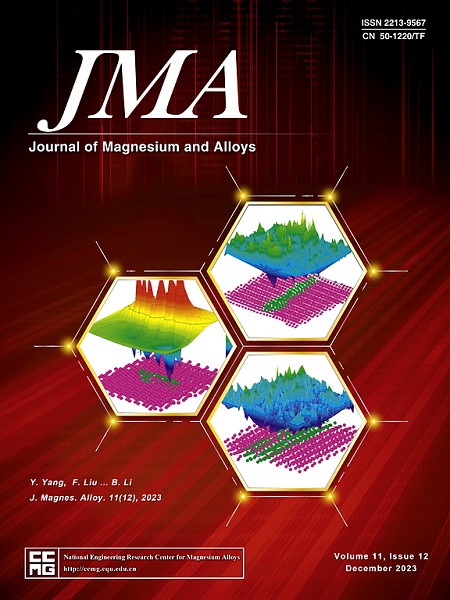Comparative study of dynamic recrystallization behavior, microstructural characteristics, and mechanical properties of high-speed-extruded AZ31 and BA56 magnesium alloys
IF 13.8
1区 材料科学
Q1 METALLURGY & METALLURGICAL ENGINEERING
引用次数: 0
Abstract
This study compares the microstructural evolution, dynamic recrystallization (DRX) behavior, tensile properties, and age-hardenability between the newly developed high-speed-extrudable BA56 alloy and those of the widely recognized AZ31 alloy in industry. Unlike the AZ31 alloy, which retains partially unrecrystallized grains, the high-speed-extruded BA56 alloy demonstrates a coarser but entirely recrystallized and more homogeneous microstructure. The fine-grained structure and abundant Mg3Bi2 particles in the BA56 extrusion billet significantly enhance its DRX behavior, thus enabling rapid and complete recrystallization during extrusion. The BA56 alloy contains band-like fragmented Mg₃Bi₂ particles and numerous fine Mg₃Bi₂ particles distributed throughout the material, in contrast to the sparse Al₈Mn₅ particles in the AZ31 alloy. These features contribute to superior mechanical properties of the BA56 alloy, which achieves tensile yield and ultimate tensile strengths of 205 and 292 MPa, respectively, compared to 196 and 270 MPa for the AZ31 alloy. The superior strength of the BA56 alloy, even with its coarser grain size, can be explained by its elevated Hall-Petch constant and the strengthening contribution from the fine Mg₃Bi₂ particles. Additionally, the BA56 alloy demonstrates significant age-hardenability, achieving a 22% enhancement in hardness following T5 aging, attributed to the precipitation of nanoscale Mg₃Bi₂ and Mg₁₇Al₁₂ phases. By contrast, the AZ31 alloy shows minimal hardening due to the absence of precipitate formation during aging. These findings suggest that the BA56 alloy is a promising candidate for the production of extruded Mg components requiring a combination of high productivity, superior mechanical performance, and wide-ranging process adaptability.

高速挤压AZ31与BA56镁合金动态再结晶行为、显微组织特征及力学性能的对比研究
本研究比较了新开发的高速挤压BA56合金与工业上广泛使用的AZ31合金的显微组织演变、动态再结晶(DRX)行为、拉伸性能和时效淬透性。与AZ31合金保留部分未再结晶晶粒不同,高速挤压BA56合金的显微组织更粗,但完全再结晶,且更均匀。BA56挤压坯料的细晶组织和丰富的Mg3Bi2颗粒显著提高了其DRX行为,从而在挤压过程中实现了快速和完全的再结晶。BA56合金含有带状破碎的Mg₃Bi₂颗粒和分布在整个材料中的许多细小的Mg₃Bi₂颗粒,与AZ31合金中稀疏的Al₈Mn₅颗粒形成对比。这些特点使得BA56合金具有优异的力学性能,其屈服强度和极限抗拉强度分别达到205和292 MPa,而AZ31合金的屈服强度和极限抗拉强度分别为196和270 MPa。尽管BA56合金的晶粒尺寸较粗,但其优异的强度可以用其较高的Hall-Petch常数和细小的Mg₃Bi₂颗粒的强化贡献来解释。此外,BA56合金表现出显著的时效淬透性,在T5时效后硬度提高了22%,这是由于纳米级Mg₃Bi₂和Mg₁₇Al₁₂相的析出。相比之下,由于时效过程中没有析出相的形成,AZ31合金表现出最小的硬化。这些发现表明,BA56合金是生产挤压镁合金部件的一个有希望的候选材料,它需要高生产率、优异的机械性能和广泛的工艺适应性。
本文章由计算机程序翻译,如有差异,请以英文原文为准。
求助全文
约1分钟内获得全文
求助全文
来源期刊

Journal of Magnesium and Alloys
Engineering-Mechanics of Materials
CiteScore
20.20
自引率
14.80%
发文量
52
审稿时长
59 days
期刊介绍:
The Journal of Magnesium and Alloys serves as a global platform for both theoretical and experimental studies in magnesium science and engineering. It welcomes submissions investigating various scientific and engineering factors impacting the metallurgy, processing, microstructure, properties, and applications of magnesium and alloys. The journal covers all aspects of magnesium and alloy research, including raw materials, alloy casting, extrusion and deformation, corrosion and surface treatment, joining and machining, simulation and modeling, microstructure evolution and mechanical properties, new alloy development, magnesium-based composites, bio-materials and energy materials, applications, and recycling.
 求助内容:
求助内容: 应助结果提醒方式:
应助结果提醒方式:


